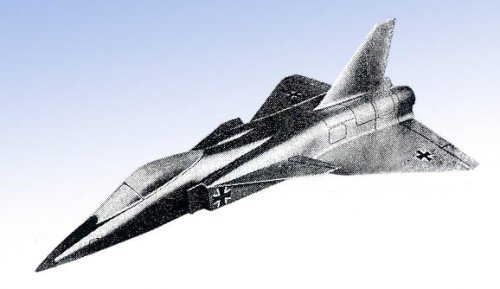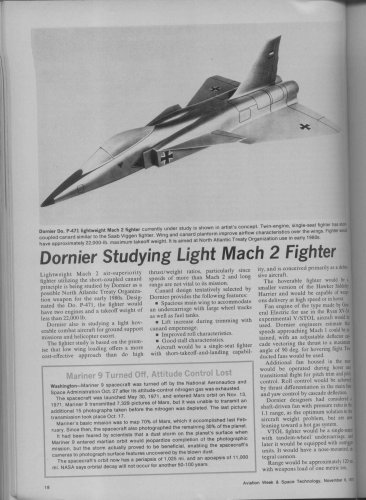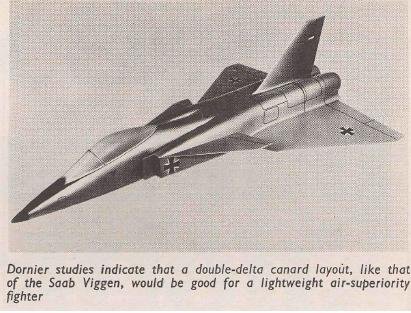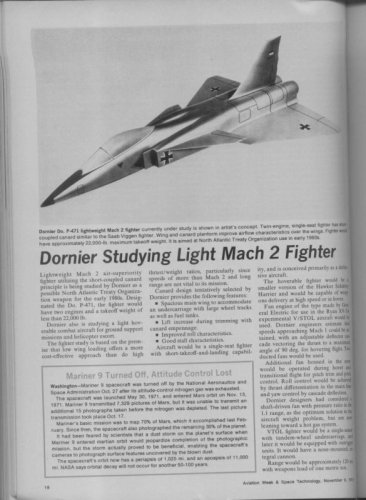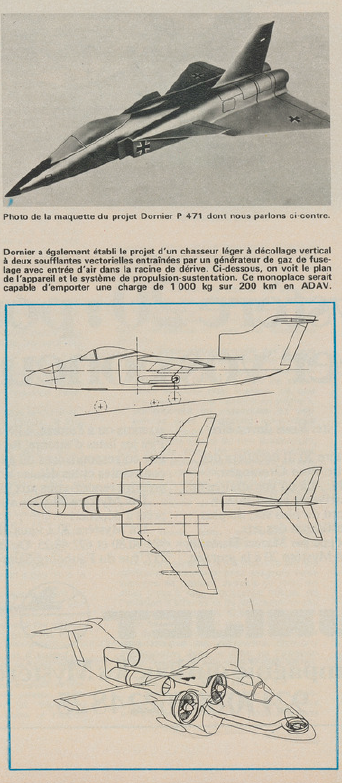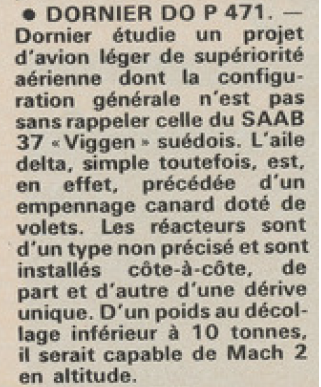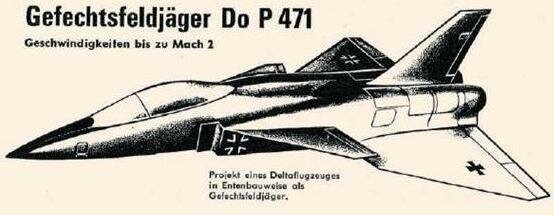You are using an out of date browser. It may not display this or other websites correctly.
You should upgrade or use an alternative browser.
You should upgrade or use an alternative browser.
1972 Dornier P-471 Canard Delta
- Thread starter JAZZ
- Start date
- Joined
- 29 September 2006
- Messages
- 1,628
- Reaction score
- 1,029
JAZZ said:This is a model of a Dornier fighter - looks early 1970's, Idea for starfighter replacement??
Anyone care to shed some light on it?
New to me, but the pic says "Dornier LAF" - meaning 'Light Attack Fighter' perhaps?
Looks like it has a nice flat belly for lots of ordinance...
Starviking
- Joined
- 26 May 2006
- Messages
- 32,695
- Reaction score
- 11,943
Hi,
the Dornier sutdied in 1972 to develope an aircraft which was based
on or looks like the SAAB-37 Viggen
the Dornier sutdied in 1972 to develope an aircraft which was based
on or looks like the SAAB-37 Viggen
Attachments
Last edited by a moderator:
- Joined
- 27 December 2005
- Messages
- 16,463
- Reaction score
- 19,179
Air superiority fighter
Dornier anticipates a Nato requirement in the early 1980s for a lightweight (less than 10,000kg gross) air-superiority fighter. The company's studies assume a "moderate" thrust to-weight ratio, slightly above unity, but with a low wing loading to provide most of the manoeuvrability. Low wing loading allows the aircraft to fly at a lower lift coefficient, thus reducing the induced drag and allowing high-g manoeuvres to be maintained. Extreme speed above Mach 2 is not a requirement, nor is long range—both would lead to a bigger aircraft. Dornier favours a twin-engined single seat canard layout for such an aircraft, which is in the Northrop P-530 class. Advantages claimed, for canards are:
• Spacious main wing to accommodate a wide-track undercarriage as well as fuel (drop tanks would also be carried).
• Lift changes are in the "correct" sense during trimming, using the foreplane.
• Excellent roll characteristics.
- Joined
- 11 March 2006
- Messages
- 8,608
- Reaction score
- 3,065
- Joined
- 27 December 2005
- Messages
- 16,463
- Reaction score
- 19,179
Aviation Week 6 November 1972

Dornier Do. P-471 lightweight Mach 2 fighter currently under study is shown in artist‘s concept. Twin-engine, single-seat fighter has short coupled canard similar to the Saab Viggen fighter. Wing and canard planform improve airflow characteristics over the wings. Fighter would have approximately 22,000-Ib. maximum takeoff weight. It is aimed at North Atlantic Treaty Organization use in early 1980s.
Dornier Studying Light Mach 2 Fighter
Lightweight Mach 2 air-superiority fighter utilizing the short-coupled canard principle is being studied by Dornier as a possible North Atlantic Treaty Organization weapon for the early 1980s. Designated the Do. P-471, the fighter would have two engines and a takeoff weight of less than 22,000 lb. Dornier also is studying a light hoverable combat aircraft for ground support missions and helicopter escort.
The fighter study is based on the premise that low wing loading offers a more cost-effective approach than do high thrust/weight ratios, particularly since speeds of more than Mach 2 and long range are not vital to its mission. Canard design tentatively selected by Dornier provides the following features:
The hoverable fighter would be a smaller version of the Hawker Siddeley Harrier and would be capable of weapons delivery at high speed or in hover. Fan engine of the type made by General Electric for use in the Ryan XV-SA experimental V/STOL aircraft would be used. Dornier engineers estimate that speeds approaching Mach 1 could be attained, with an adjustable deflector cascade vectoring the thrust to a maximum angle of 90 deg. for hovering flight. Two ducted fans would be used. Additional fan housed in the nose would be operated during hover and transitional flight for pitch trim and pitch control. Roll control would be achieved by thrust differentiation in the main fans and yaw control by cascade deflection.
Dornier designers had considered a shaft-driven fan with pressure ratio in the 10:1 range, as the optimum solution to the aircraft weight problem, but are now leaning toward a hot gas system. VTOL fighter would be a single-seater with tandem-wheel undercarriage, and later it would be equipped with outrigger units. It would have a nose-mounted, integral cannon. Range would be approximately 120 mi. with weapons load of one metric ton.
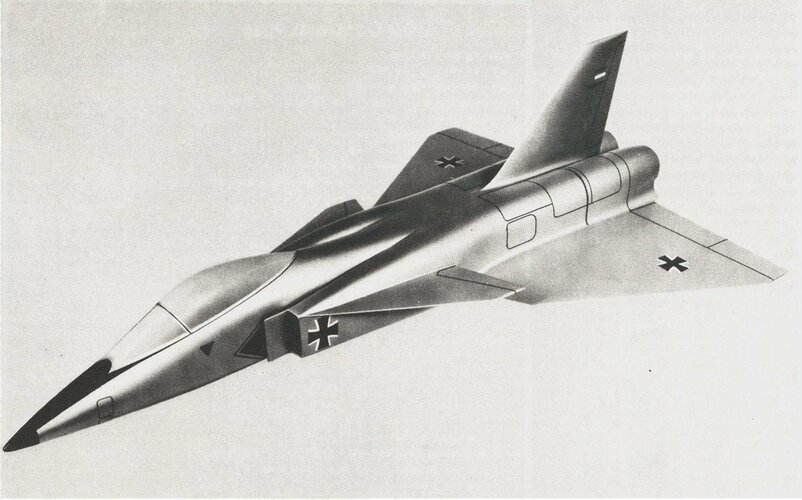
Dornier Do. P-471 lightweight Mach 2 fighter currently under study is shown in artist‘s concept. Twin-engine, single-seat fighter has short coupled canard similar to the Saab Viggen fighter. Wing and canard planform improve airflow characteristics over the wings. Fighter would have approximately 22,000-Ib. maximum takeoff weight. It is aimed at North Atlantic Treaty Organization use in early 1980s.
Dornier Studying Light Mach 2 Fighter
Lightweight Mach 2 air-superiority fighter utilizing the short-coupled canard principle is being studied by Dornier as a possible North Atlantic Treaty Organization weapon for the early 1980s. Designated the Do. P-471, the fighter would have two engines and a takeoff weight of less than 22,000 lb. Dornier also is studying a light hoverable combat aircraft for ground support missions and helicopter escort.
The fighter study is based on the premise that low wing loading offers a more cost-effective approach than do high thrust/weight ratios, particularly since speeds of more than Mach 2 and long range are not vital to its mission. Canard design tentatively selected by Dornier provides the following features:
- Spacious main wing to accommodate an undercarriage with large wheel tracks as well as fuel tanks.
- Lift increase during trimming with canard empennage.
- Improved roll characteristics.
- Good stall characteristics.
The hoverable fighter would be a smaller version of the Hawker Siddeley Harrier and would be capable of weapons delivery at high speed or in hover. Fan engine of the type made by General Electric for use in the Ryan XV-SA experimental V/STOL aircraft would be used. Dornier engineers estimate that speeds approaching Mach 1 could be attained, with an adjustable deflector cascade vectoring the thrust to a maximum angle of 90 deg. for hovering flight. Two ducted fans would be used. Additional fan housed in the nose would be operated during hover and transitional flight for pitch trim and pitch control. Roll control would be achieved by thrust differentiation in the main fans and yaw control by cascade deflection.
Dornier designers had considered a shaft-driven fan with pressure ratio in the 10:1 range, as the optimum solution to the aircraft weight problem, but are now leaning toward a hot gas system. VTOL fighter would be a single-seater with tandem-wheel undercarriage, and later it would be equipped with outrigger units. It would have a nose-mounted, integral cannon. Range would be approximately 120 mi. with weapons load of one metric ton.
Last edited:
- Joined
- 27 December 2005
- Messages
- 16,463
- Reaction score
- 19,179
# Проект истребителя Dornier Do P471 (ФРГ)
Проект этого самолёта разрабатывался немецкой фирмой Дорнье в 1973 году с явной оглядкой на шведский самолёт JA-37 Viggen . Тут также планировалось создать самолёт с коротким взлётом и посадкой с возможностью взлёта с участков автострад. Самолёт должен был оснащаться ПГО создающим…
 raigap.livejournal.com
raigap.livejournal.com
Attachments
acegeek9992
ACCESS: Confidential
- Joined
- 25 March 2021
- Messages
- 111
- Reaction score
- 72
What engines would the P.471 have used?Aviation Week 6 November 1972
View attachment 676277
Dornier Do. P-471 lightweight Mach 2 fighter currently under study is shown in artist‘s concept. Twin-engine, single-seat fighter has short coupled canard similar to the Saab Viggen fighter. Wing and canard planform improve airflow characteristics over the wings. Fighter would have approximately 22,000-Ib. maximum takeoff weight. It is aimed at North Atlantic Treaty Organization use in early 1980s.
Dornier Studying Light Mach 2 Fighter
Lightweight Mach 2 air-superiority fighter utilizing the short-coupled canard principle is being studied by Dornier as a possible North Atlantic Treaty Organization weapon for the early 1980s. Designated the Do. P-471, the fighter would have two engines and a takeoff weight of less than 22,000 lb. Dornier also is studying a light hoverable combat aircraft for ground support missions and helicopter escort.
The fighter study is based on the premise that low wing loading offers a more cost-effective approach than do high thrust/weight ratios, particularly since speeds of more than Mach 2 and long range are not vital to its mission. Canard design tentatively selected by Dornier provides the following features:
Aircraft would be a single-seat fighter with short-takeoff—and-landing capability, and is conceived primarily as a defensive aircraft.
- Spacious main wing to accommodate an undercarriage with large wheel tracks as well as fuel tanks.
- Lift increase during trimming with canard empennage.
- Improved roll characteristics.
- Good stall characteristics.
The hoverable fighter would be a smaller version of the Hawker Siddeley Harrier and would be capable of weapons delivery at high speed or in hover. Fan engine of the type made by General Electric for use in the Ryan XV-SA experimental V/STOL aircraft would be used. Dornier engineers estimate that speeds approaching Mach 1 could be attained, with an adjustable deflector cascade vectoring the thrust to a maximum angle of 90 deg. for hovering flight. Two ducted fans would be used. Additional fan housed in the nose would be operated during hover and transitional flight for pitch trim and pitch control. Roll control would be achieved by thrust differentiation in the main fans and yaw control by cascade deflection.
Dornier designers had considered a shaft-driven fan with pressure ratio in the 10:1 range, as the optimum solution to the aircraft weight problem, but are now leaning toward a hot gas system. VTOL fighter would be a single-seater with tandem-wheel undercarriage, and later it would be equipped with outrigger units. It would have a nose-mounted, integral cannon. Range would be approximately 120 mi. with weapons load of one metric ton.
- Joined
- 27 December 2005
- Messages
- 16,463
- Reaction score
- 19,179
What engines would the P.471 have used?
Not known, but looks like perhaps 2 x J97? They look slim but J85s wouldn't be powerful enough.
acegeek9992
ACCESS: Confidential
- Joined
- 25 March 2021
- Messages
- 111
- Reaction score
- 72
Weren't J97s mostly used for drones like the YQM-94 B-Gull and AQM-91 Firefly? I do know that there was the J97-GE-17 variant with 11,760 lbf (52,300 N) thrust meant for use on the O4-1B Robin supersonic bizjet though.What engines would the P.471 have used?
Not known, but looks like perhaps 2 x J97? They look slim but J85s wouldn't be powerful enough.
- Joined
- 27 December 2005
- Messages
- 16,463
- Reaction score
- 19,179
The early P.530 designs that led to the YF-17 used twin afterburning J97s, before switching to the larger J101/F404.
Its just a guess, I would assume 3500-5000kg thrust per engine. too much for an Adour of the era. RB153 seems too big diameter. Not sure what else was in this thrust class?
Its just a guess, I would assume 3500-5000kg thrust per engine. too much for an Adour of the era. RB153 seems too big diameter. Not sure what else was in this thrust class?
Similar threads
-
Dornier LSK (Leichtes Schwebefähiges Kampfflugzeug) (Lightweight hoverable fighter) (1972)
- Started by hesham
- Replies: 13
-
Dornier's light fighter design for India in 1984
- Started by datafuser
- Replies: 1
-
Convair San Diego Model 23 Naval Fighter, 1970 - 1973
- Started by overscan (PaulMM)
- Replies: 5
-
Vought Advanced Programs - Canard Delta Design
- Started by Mark Nankivil
- Replies: 22
-

